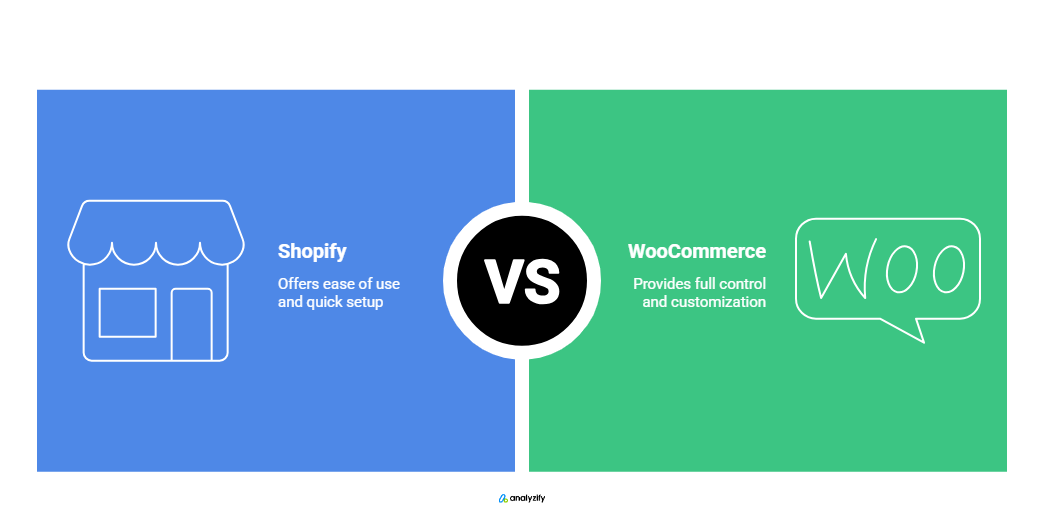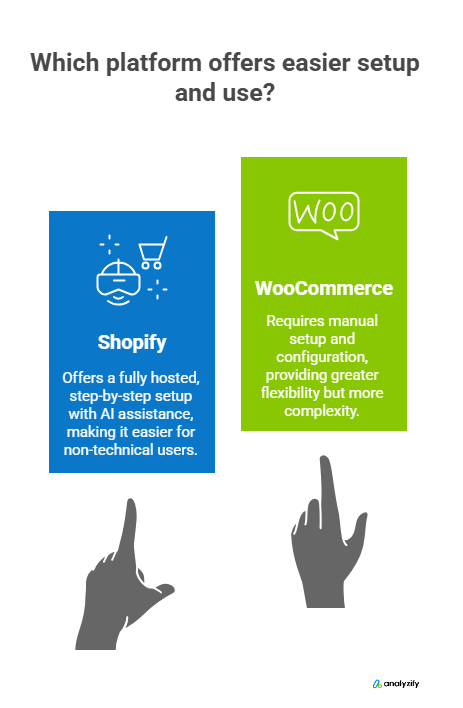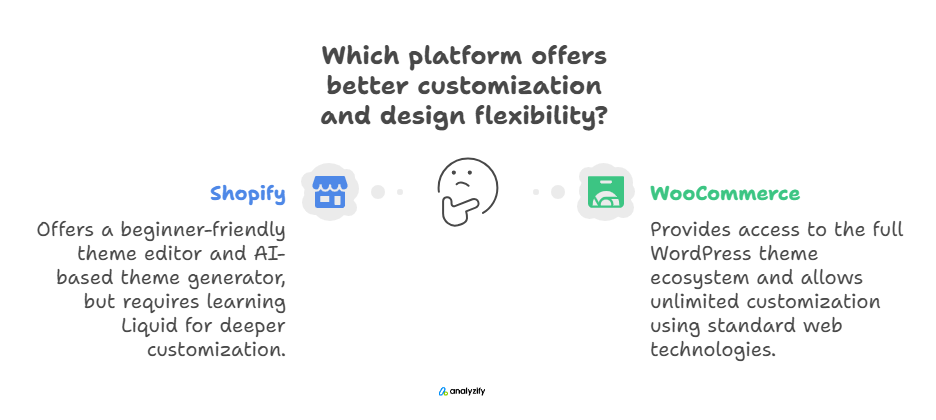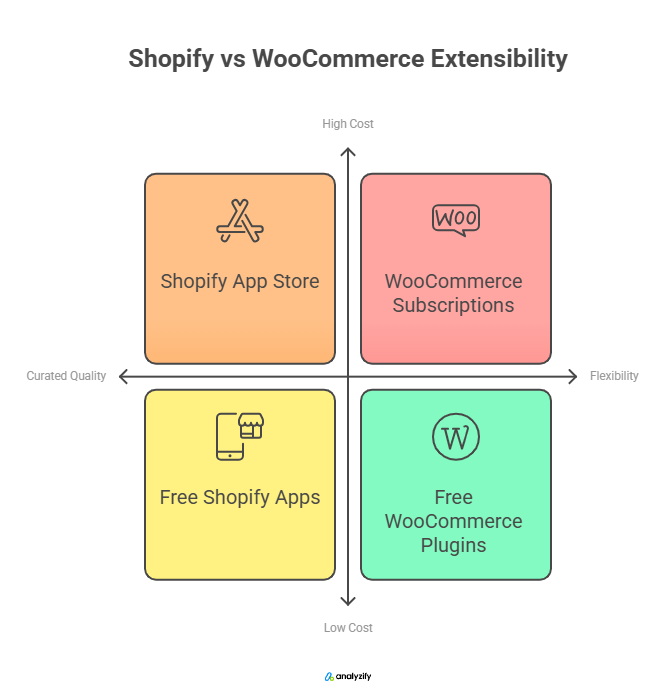Shopify and WooCommerce are two of the most widely used ecommerce platforms today.
While Shopify offers an all-in-one hosted solution, WooCommerce is a flexible WordPress plugin that gives users full control over their online store.

Both platforms are powerful, but they cater to different needs, budgets, and technical skill levels.
This comparison will break down the differences between Shopify and WooCommerce across essential areas like pricing, ease of use, customization, SEO, scalability, and more.
If you’re deciding which platform to use, this guide will help you make an informed choice based on practical considerations.
Which Is Better: Shopify vs WooCommerce
Shopify is a fully hosted ecommerce platform designed for merchants who want to launch quickly without dealing with technical setup or maintenance.
It’s widely used by direct-to-consumer brands, small businesses, and large-scale stores that prioritize speed, reliability, and ease of use.
People often choose Shopify because everything from hosting to payment processing is built in, so they can focus on selling instead of setup.
Some of the well-known brands using Shopify include Gymshark, Allbirds, and Kylie Cosmetics.

On the other hand, WooCommerce is one of Shopify’s biggest rivals.
It’s an open-source plugin built for WordPress, giving users complete control over their store’s design, functionality, and hosting environment.
It’s a great fit for businesses that already use WordPress, or for those who want flexibility in how they manage their store.
WooCommerce powers sites for brands like Weber, AeroPress, and Blue Star Coffee.
TL;DR: Who Wins Overall?
Shopify: Best for users who want a turnkey solution, minimal technical management, and predictable costs. Ideal for fast launches, non-technical users, and scaling without developer dependence.
WooCommerce: Best for those who value full control, customizability, and long-term ownership. Ideal for developers, tech-savvy teams, or businesses seeking full creative and operational freedom.
Shopify vs WooCommerce: Pricing and Total Cost of Ownership
✅ Who Wins for Pricing: WooCommerce
When comparing Shopify vs WooCommerce on pricing, the key difference is simple: Shopify has fixed, bundled plans while WooCommerce is modular and self-managed.
Below is a detailed pricing comparison of Shopify vs WooCommerce:

Shopify Pricing
- Starts at $29/month, with mid and advanced tiers at $79 and $299
- Shopify Plus starts at $2,500/month, targeting enterprise brands
- 3-day free trial + $1/month for the first 3 months (as of 2025)
- Additional costs:
- Premium themes ($100–$380 one-time)
- Apps (many range from $10–$200/month)
- Transaction fees (2.9% + $0.30 on Basic plan if not using Shopify Payments)
WooCommerce Pricing (Flexible, but Variable)
- WooCommerce plugin: Free
- Hosting: $6–$450/month depending on provider and traffic
- Domain: $10–$20/year
- SSL certificate: Often free, premium options available
- Themes: Free to $130/year
- Plugins/extensions: Free to $129+/year per plugin
- No platform-level transaction fees (only what gateways like Stripe or PayPal charge)
Ease of Use and Setup Of Shopify & WooCommerce
✅ Who Wins for Ease of Use: Shopify
One of the most important factors when choosing a platform is how quickly you can get your store up and running, especially if you’re not technically inclined.
Here’s a side-by-side breakdown of Shopify vs WooCommerce ease of use and setup:

Shopify Ease of Use
- Fully hosted with a step-by-step onboarding process
- Product uploads, theme selection, and basic settings are all handled from a clean dashboard
- AI features like Shopify Magic help with product descriptions and media
- Shopify Sidekick offers AI-powered support for setup and management
- Hosting, SSL, security, and updates are all included
WooCommerce Ease of Use
- Requires installing WordPress + WooCommerce plugin
- You need to choose and configure your own hosting, domain, and SSL
- Greater flexibility, but more manual setup
- Newer block themes like Twenty Twenty-Four improve usability
- Setup takes longer if you’re starting from scratch
- Managed WooCommerce hosting (e.g. Bluehost) helps reduce setup burden
Shopify vs WooCommerce: Analytics & Tracking
✅ Who Wins for Analytics & Tracking: Shopify
Tracking and analytics are key to growing your store.
Shopify offers a plug-and-play experience with built-in reports. WooCommerce, on the other hand, gives you complete control—but it requires more setup.
Shopify Analytics & Tracking
- Built-in analytics dashboard with sales, sessions, conversion rates
- Custom reports available on higher-tier plans
- Shopify Pixel Manager for easy integration with Meta, GA4, TikTok, etc.
- Real-time insights, marketing attribution, and product-level performance
- App integrations for advanced reporting (e.g. Elevar, Triple Whale)
- Easier to set up, especially for non-technical users
WooCommerce Analytics & Tracking
- WooCommerce Analytics plugin provides customizable dashboards
- Full GA4, GTM, and Enhanced Ecommerce compatibility
- Highly flexible setup through plugins or custom code
- Supports server-side tracking and headless implementations
- Requires more technical skills or developer involvement
- Plugin support and update reliability vary by vendor
Note: For advanced tracking on Shopify, tools like Analyzify make it easy to implement GA4, Meta, TikTok, and server-side tagging.
It’s a plug-and-play solution trusted by thousands of merchants. Explore now!
Analyzify provides a turnkey solution to more than 50 challenging tracking problems for Shopify merchants.
Customization and Design Flexibilities
✅ Who Wins for Customization: WooCommerce
Design flexibility is key to building a storefront that reflects your brand.
Both platforms offer theme libraries and editing tools, but they differ significantly in how far you can go with customization.
See how Shopify and WooCommerce differ in customization and design flexibility:

Shopify Customization
- Offers 200+ professionally designed themes (13 free, the rest paid)
- Most themes are mobile-optimized and include features like stock counters, quick view, and mega menus
- Theme editor is beginner-friendly but limited for advanced changes
- Deeper customization requires learning Liquid, Shopify’s proprietary templating language
- AI-based theme generator (2025 update) allows basic personalization via prompts
- Switching themes preserves your content
WooCommerce Customization
- Access to the full WordPress theme ecosystem, including WooCommerce-specific themes
- Full site editing via block-based themes like Twenty Twenty-Four
- Developers can create fully custom themes using PHP, CSS, HTML, and JS
- Unlimited flexibility to modify layouts, product pages, checkout, and more
- Many themes and extensions offer reusable blocks and pre-designed patterns
- No proprietary language—developers use standard web technologies
Hosting and Maintenance Of Shopify vs Woocommerce
✅ Who Wins for Hosting Simplicity: Shopify
How your store is hosted affects site speed, uptime, and how much time you spend on technical upkeep.
Shopify offers a fully managed environment, while WooCommerce puts you in charge.
Here’s how the hosting and maintenance of Shopify and WooCommerce compares:

Shopify Hosting
- Fully hosted on Shopify’s infrastructure
- 99.99% uptime and fast global performance
- SSL certificate, PCI compliance, backups, and updates included
- No need to manage servers, security patches, or updates
- Auto-scaling handles traffic spikes with no user action
WooCommerce Hosting
- You choose your own hosting provider (shared, VPS, or dedicated)
- Performance and security depend heavily on the host you select
- SSL, backups, and speed optimizations vary by provider
- More effort required to manage updates for WordPress, WooCommerce, and plugins
- Offers more flexibility to optimize performance for unique business needs
- Managed WooCommerce hosting (e.g., Bluehost Commerce Plan) reduces technical workload
Shopify vs WooCommerce: SEO and Content Capabilities
***✅ Who Wins for SEO Control: WooCommerce**
Ranking well on search engines is critical for long-term traffic and visibility.
Both platforms offer SEO tools, but WooCommerce gives you more flexibility and deeper control.
An overview of Shopify and WooCommerce’s SEO capabilities are listed below:

Shopify SEO
Built-in features include:
- Editable meta titles and descriptions
- Automatic sitemap.xml and canonical URLs
- Schema markup for products and pages
Mobile-optimized themes and fast hosting help with Core Web Vitals
Limited control over advanced SEO settings (e.g. full URL structure, redirect handling)
Apps like SEO Manager or Plug in SEO provide enhancements
Good enough for basic to intermediate SEO needs
WooCommerce SEO
- Full integration with powerful WordPress SEO plugins like Yoast and All in One SEO
- Control over every SEO element: titles, descriptions, permalinks, sitemaps, schema, etc.
- Strong support for content-driven SEO through native blogging tools
- Better suited for long-form content, custom taxonomies, and editorial SEO strategies
- Ability to customize SEO settings per page, post, or product
- Dependent on user or plugin setup, so results vary by implementation quality
Payment Option Differences Of Shopify and WooCommerce
✅ Who Wins for Payment Flexibility: WooCommerce
How your store handles payments impacts both user experience and your bottom line.
Shopify simplifies setup, but WooCommerce offers more flexibility and fewer platform restrictions.
Below, we outline the key payment differences between Shopify and WooCommerce:
Shopify Payments
- Built-in Shopify Payments gateway with competitive rates:
- Basic plan: 2.9% + $0.30 per transaction
- Advanced plans offer lower fees
- No additional transaction fees if you use Shopify Payments
- If using third-party gateways (e.g. PayPal, Stripe), Shopify charges an extra 0.5%–2%
- Supports digital wallets (Apple Pay, Google Pay), BNPL options (Klarna, Afterpay), and POS
- Multi-currency supported, but only via Shopify Payments
- Multi-market pricing limited on lower-tier plans
WooCommerce Payments
- No additional platform transaction fees—only what the payment gateway charges
- Works with Stripe, PayPal, Square, Amazon Pay, Authorize.net, and dozens more
- WooPayments (Stripe-based) offers:
- 2.9% + $0.30 per U.S. transaction
- Multi-currency support built-in
- Can enable local or regional gateways for international markets
- No restrictions on using multiple gateways at once
- Full control over checkout customization
Extensions and App Ecosystem of Shopify and WooCommerce
✅ Who Wins for Extensibility: WooCommerce
Both platforms support apps and extensions to expand your store’s functionality.
Shopify focuses on curated quality and ease of use, while WooCommerce emphasizes flexibility and depth.

Shopify App Ecosystem
- 8,000+ apps available in the Shopify App Store
- Easy to install and integrate—no coding needed for most
- Covers everything from email marketing to reviews, loyalty programs, and subscriptions
- Many apps require monthly fees ($10–$200/month each)
- Strong developer guidelines help ensure app quality and security
- Some features locked behind paid apps or higher-tier plans
WooCommerce Extensions
- Thousands of free and paid plugins via WooCommerce, WordPress, and third-party developers
- Full access to modify plugins or build custom ones
- Popular premium extensions:
- WooCommerce Subscriptions
- WooCommerce Bookings
- WooCommerce Memberships
- Plugin quality and compatibility vary—requires more hands-on management
- Most plugins are sold as one-time purchases or annual licenses (no ongoing monthly fees unless SaaS-based)
Scalability and Performance Of WooCommerce vs Shopify
✅ Who Wins for Strategic Scaling: WooCommerce
Both platforms can handle growth, but they scale differently.
Shopify offers convenience through built-in infrastructure, while WooCommerce gives you control to scale on your own terms.
Shopify Scalability
- Built-in hosting automatically scales with traffic spikes
- Enterprise-grade option: Shopify Plus ($2,500+/month)
- Suited for fast-growing brands that want to avoid infrastructure management
- Performance is consistent, but scaling beyond standard use cases often requires upgrading to higher plans or working within Shopify’s limitations
- Resource allocation and performance handled entirely by Shopify
WooCommerce Scalability
- No hard limits—scalability depends on your hosting environment and site optimization
- Can handle thousands of products, high-traffic spikes, and global customers
- Full control to optimize caching, CDN, database, and codebase
- Requires developer support or managed hosting for advanced scaling
- WooCommerce Enterprise offers priority support, migration help, and infrastructure planning
Who Wins For Internationalization: Shopify vs WooCommerce
✅ Who Wins for Global Selling: Shopify
Selling internationally involves multiple stores, multiple currencies, languages, and tax requirements.
Both platforms support global sales, but Shopify makes it easier to launch and manage without heavy customization.
Shopify Global Capabilities
Shopify Markets simplifies international setup
Native support for:
- Multi-currency
- Language translation
- Duties and taxes
- International domains
Translate your store manually or with apps like Shopify Translate & Adapt
Currency support is automatic with Shopify Payments
Multiple languages can be enabled from the Shopify admin
WooCommerce Global Capabilities
- Full multilingual and multi-currency support via plugins (e.g., WPML, Polylang, Currency Switcher)
- Needs manual configuration or multiple plugin combinations
- Tax rules and regional pricing managed through extensions
- Greater flexibility but more setup time and compatibility checks required
- Ideal for sites already using WordPress with international audiences
Read More: Shopify Plus vs. Shopify Markets: What’s the Difference, and Which Do You Need?
Security & Compliance Options Of Shopify vs WooCommerce
✅ Who Wins for Security and Compliance: Shopify
Security is non-negotiable for ecommerce. Shopify and WooCommerce both take it seriously, but their approaches differ: one is hands-off, the other is DIY.

Shopify Security
- Fully hosted and maintained by Shopify
- PCI DSS compliant by default
- SSL certificates included in all plans
- Built-in fraud analysis tools
- 2FA and role-based staff permissions
- Regular updates and server-level security handled by Shopify
- GDPR features like cookie banners available via app integrations
WooCommerce Security
- Depends entirely on your hosting and setup
- SSL support depends on host (most provide it)
- PCI compliance is not automatic — must be configured
- Security plugins needed (Wordfence, iThemes Security, etc.)
- 2FA available via third-party plugins
- You’re responsible for core, plugin, and theme updates
- GDPR compliance must be manually configured via plugins or custom development
Help & Support Of Shopify and WooCommerce
✅ Who Wins for Support: Shopify
Running an online store often means needing quick answers.
Shopify offers more centralized and accessible support, while WooCommerce relies heavily on community and third-party providers.
Shopify Support
- 24/7 customer support via live chat, email, and phone
- Large knowledge base and help center
- Shopify Academy and webinars for learning
- Priority support for Shopify Plus users
- App and theme developers usually provide dedicated support
- Shopify Community forums for peer help
WooCommerce Support
- Core plugin support via WooCommerce.com tickets
- Documentation for core features and extensions
- No direct phone or live chat support
- Community forums and third-party blogs/Youtube tutorials
- Plugin and theme support varies by developer
- If you use external hosting, support requests may be split between host and WooCommerce
Shopify vs WooCommerce: Final Verdict
✅ Overall Winner: Shopify (for most users)
Choosing between Shopify and WooCommerce depends on what you value most: simplicity and speed, or flexibility and control.
Recap: Shopify vs WooCommerce Comparison
Shopify is best for you if:
- You want a fully managed solution with minimal technical setup
- You prioritize speed, reliability, and centralized support
- You’re focused on launching fast and scaling without technical bottlenecks
- You prefer predictable monthly costs
WooCommerce is best for you if:
- You need full control over every aspect of your store
- You’re comfortable managing hosting, plugins, and performance tuning
- You want to customize extensively or integrate unique features
- You’re optimizing for cost-efficiency in the long term
Both platforms are capable, but serve different types of merchants. Shopify wins on ease of use, support, built-in features, and getting merchants to market faster.
WooCommerce offers deep customization and flexibility for users who have the resources or technical know-how to manage it all.
Conclusion
Shopify is ideal for those who want simplicity, support, and fast setup. WooCommerce is better for users who need full control and flexibility.
Your choice comes down to how much time, technical skill, and customization you’re willing to manage.
Read More:

































